Asheville Watchdog sues City of Asheville, alleging open meetings law violations
The detention of three children and their mother shocked a Northern New York town. It also highlighted just how much the region’s key industries depend on immigrant workers.

It's Friday, April 11, 2025, and in this morning's edition we're covering an Asheville nonprofit news outlet suing the City of Asheville, Solar microgrids could keep rural health clinics operational during power outages, how much Northern New York State relies on immigrants, Louisiana's governor wants to add two additional members to the state's public service commission, Alabama Rep. Terri Sewell says protests can get the current presidential administration to reverse course, multiple states investigate stillbirths and miscarriages as crimes and a lot more.
Media outlets and others featured in this edition: Asheville Watchdog, North Carolina Health News, New York Focus, The Intercept, Louisiana Illuminator, NOTUS, The Marshall Project, Utah News Dispatch, VTDigger, The City.
To continue reading the rest of each article, please click the link at the end of the excerpt.
A new resource from the State Democracy Research Initiative makes the current text of all 50 state constitutions available and searchable on one site. This was from State Court Report.
Bolts has a guide to each state's supreme court.
Journalist Ben Ledbetter started and edits Down Ballot, a weekly curated report of state and local government news from nonprofit news sources.
The nonprofit news outlet contends officials illegally closed water committee meetings to reporters, public following 2022-23 freeze, widespread water outage
by PETER LEWIS April 9, 2025
Asheville Watchdog is suing the City of Asheville over its refusal to allow reporters and the public to attend meetings of the Independent Review Committee (IRC), which was created to investigate the causes of a catastrophic water system failure over the 2022-2023 holiday season.
Our lawsuit asks the court to declare the city violated North Carolina’s open meetings law and to prevent it from creating future advisory committees that operate in secrecy.
We took this extraordinary step reluctantly, filing a legal complaint only after more than two years of unsuccessful requests to the city and the city attorney to honor the spirit as well as the letter of the law.
Simply put, we believe that the public’s business should be conducted in public, not secretly behind closed doors. The City of Asheville, meanwhile, has repeatedly held policy-shaping discussions in ways that appear deliberately intended to circumvent the law.
Our complaint was filed in Buncombe County Superior Court by Duke University Law School’s First Amendment Clinic on behalf of Asheville Watchdog and Sunshine Request, a public interest project based in Asheville that publishes the results of public records requests.
The failure of Asheville’s water system on Christmas Eve 2022 affected tens of thousands of residents and hundreds of local businesses, costing untold millions in losses over the 11 days it took city officials to fully restore service. How did it happen? Why did recovery take so long? Did city officials and employees screw up in managing its water systems before and during the disaster? What local government policies need to be changed to prevent this kind of debacle from happening again?
All are legitimate questions of undeniable public interest, which city officials acknowledged by forming the IRC. Then they refused to allow us access to the committee meetings, even when city officials were in the room. The city also required all members of the committee to sign nondisclosure agreements. The city maintained the IRC was not an advisory body, yet its final report included 24 recommendations to the City Council.
Was the IRC — created by the City Council to advise the council and make policy recommendations — a “public body” subject to the state’s open meetings law? The Watchdog and Sunshine Request say yes. The City of Asheville says no. We trust the court to decide.
Our lawsuit comes at a time when, across the country, from the White House and Congress to the General Assembly in Raleigh — and, sadly, in Asheville and Buncombe County, too — lawmakers are thumbing their noses at “sunshine” and open government laws that were enacted to protect the public’s right to know how our elected officials conduct their business and spend taxpayers’ money.
Open meetings and public records laws are crucial to government transparency, accountability, and public trust in government. They reduce the likelihood of backroom deals and hidden agendas. The City of Asheville officially claims to support transparency, and insists it is following the open meetings laws, yet it has a long history of contorting its meetings to avoid public scrutiny.
Our complaint follows years of attempts by local government leaders to evade the spirit of the open meetings law while claiming legal and technical adherence to it. The city’s selective approach to transparency continues to this day.
We’ve written before about the City Council’s longtime practice of check-in meetings, regular sessions consisting of the mayor and other city officials but no more than two other council members — deliberately limited in size to avoid constituting a quorum that would trigger the state’s open meetings law.
The public is denied access to those types of meetings, and the city doesn’t provide notice of when they occur or what is discussed. The same meeting is repeated three times to accommodate the six council members, two at a time, without triggering the open meetings law.
Patrick Conant of Sunshine Request has confirmed that check-in meetings have resumed, even after the City Council voted in 2023 to replace them with public work sessions.
Asheville City Attorney Brad Branham previously told The Watchdog that check-ins are legal and give Council members an opportunity to ask questions, speak freely and “ensure that they are updated on any kind of critical matters going on.”
On March 5, Asheville Watchdog and Sunshine Request gave the City of Asheville a final opportunity to avoid the lawsuit by adopting policies that would ensure future committees comply with the open meetings law.
“The City disagrees with your opinion that the IRC was a public body as defined by the North Carolina open meetings law,” Branham responded to the Duke Law First Amendment Clinic the next day.
We’ll never know if public scrutiny of the IRC meetings might have prepared us better to deal with the even more catastrophic water outages caused by Tropical Storm Helene not even two years later. Nor do we know that the city won’t create similar committees to assess and implement public policies that affect us all in the future, outside the public eye, and that’s what we’re trying to prevent with our lawsuit.
But what we do know is that the public’s trust in the process is weakened by the city’s transparent disregard for transparency.
Asheville Watchdog is grateful to Kyle Compton, Sarah Ludington, Amanda Martin, and the students at the Duke Law School First Amendment Clinic for their generous assistance in preparing this legal action on our behalf.
Asheville Watchdog welcomes thoughtful reader comments about this story, which has been republished on our Facebook page. Please submit your comments there.
Asheville Watchdog is a nonprofit news team producing stories that matter to Asheville and Buncombe County. Peter H. Lewis is The Watchdog’s executive editor. Email: plewis@avlwatchdog.org. To show your support for this vital public service go to avlwatchdog.org/support-our-publication/.
Read more (including the 228-page complaint):
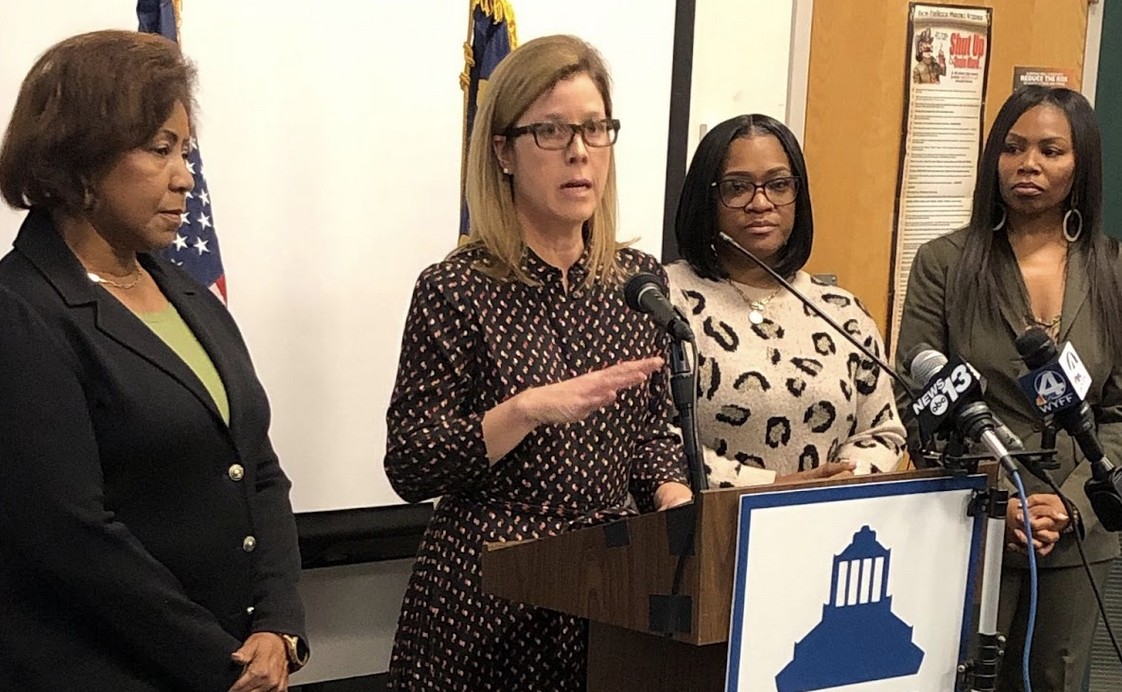
In the wake of disasters, rural health could end up running on sunshine
Solar microgrids and other modern technologies could transform care delivery in disaster-prone, underserved areas.
by Will Atwater April 2, 2025
When Hurricane Helene ripped through western North Carolina, it downed power lines, leaving tens of thousands of residents without electricity for days, even weeks.
Duke Energy reported “severe” infrastructure damage, including submerged substations, thousands of downed utility poles and fallen transmission towers. The company also noted that mudslides, flooding and blocked roads hampered efforts to quickly restore power.
At Duke Energy’s Marshall Substation in the town of Hot Springs, heavy rains and flooding forced the shutdown of the facility. But Hot Springs was more fortunate than most. In 2023, Duke Energy had installed a microgrid of solar panels and lithium-ion batteries to restore power quickly in case of emergency.
A microgrid is a self-contained electricity system that can operate independently of, or in coordination with, the main power grid. A common example is rooftop solar panels that supply electricity to homes, enabling residents to either disconnect from the main grid entirely or rely on it only as needed.
Hot Springs’ system, which can provide 100 percent of the town’s peak load and up to six hours of backup power, went live on Oct. 2, only five days after the storm. The microgrid operated continuously for the next 143.5 hours, providing power to the town’s center until power was restored to the area on Oct. 8.
The project, initially intended to be a proof of concept, worked to help the town get back online far ahead of its neighbors.
“It wasn’t as luxurious as a typical grid-powered home,” said Sara Nichols, energy and economic program manager for the Land of Sky Regional Council, a multi-county, local government organization. “It kept that town going when most people had nothing. It’s a huge success story.”
Hurricane Maria provides example
Rural and community health centers are a vital safety net for millions of Americans.
“As the largest primary care network in the nation, community health centers serve one in three people living in poverty — many in communities most impacted by environmental and climate hazards,” said Kyu Rhee, president and chief operating officer of the National Association of Community Health Centers, in a 2024 news release.
“Community health centers [are] not for profit organizations that receive a limited amount of federal support to provide care to anyone — [including] primary medical, dental, behavioral health, discounted Pharmacy [services] — and there in all 50 states and territories,” said Ben Money, from the association.
Money used to run the N.C. Community Health Center Association and knows the needs of this state well, including its extensive history of hurricanes disrupting power to crucial services. He pointed to Hurricane Maria, which devastated Puerto Rico’s power grid in 2017, as a turning point that accelerated efforts to equip health centers with solar-powered microgrids to improve disaster recovery.
Arturo Massol-Deyá, executive director of Casa Pueblo de Adjuntas, a nonprofit community organization based in Puerto Rico, described the conditions on the ground after Maria.
Read More:

‘An Open Secret’: Sackets Harbor ICE Raid Shows the ‘Reality’ of New York Dairy Country
Julia Rock · April 9, 2025
Residents of Sackets Harbor, a small New York town that looks at Canada across Lake Ontario, have been reeling since federal immigration enforcement agents raided a dairy farm there last month. Agents detained three students enrolled in the town’s 400-student K-12 school — a third grader, tenth grader, and eleventh grader — along with their mother.
The raid “shocked” Jaime Cook, the school principal. Cook grew up in California’s agriculture-heavy Central Valley, where many workers are immigrants and circumstances like this were more familiar, she said. “It’s so shocking that it happened here,” she told New York Focus. “We’re not an immigration hub.”
Sackets Harbor may not be an immigration hub, but it is in farm country — and more specifically, dairy country. More than half of the workers on New York’s dairies are foreign-born, some experts estimate.
The dairy industry is responsible for about half of the state’s agricultural output. Nearly 3,000 farms produce more than 16 billion pounds of milk a year — more than most other states. The industry is largely concentrated in Central, Western, and Northern New York, where it’s a major economic force in rural communities.
The raid there has foregrounded a fragile reality, which is that employers in some of the region’s key industries consider immigrant workers essential to their operations, but many are not legally authorized to work. While immigration enforcement has always loomed large over the industry, some farmers are anticipating a heightened threat to their workforces — and therefore to their businesses.
President Donald Trump has repeatedly promised “mass deportations” of immigrants. His administration has said it will resume immigration raids on workplaces, which were largely halted under the Biden administration, and it has ramped up immigration enforcement in upstate New York in recent weeks.
After spending more than a week in a Texas detention center, the Sackets Harbor children and their mother were released on April 7 without a clear explanation for why they were detained in the first place. Their detention has rocked a small town and school community in a county that is almost entirely represented by Republicans across all levels of government and voted for Trump by large margins in 2024.
School superintendent Jennifer Gaffney said in a statement after their release, “In the midst of this difficult time, the strength, compassion, and resilience of our community have shone through.”
Sackets Harbor is a town of about 1,300 people in the northernmost part of the state. Boats are parked in a marina on Lake Ontario, and Tom Homan, Trump’s “border czar” who grew up in the North Country, recently bought a summer home on the water.
Old McDonald’s Farm, an 8,000-acre operation that produces crops like corn and soybeans, beef cattle, and milk from about 1,500 dairy cows, sits on the edge of town. Large signs on the road into town advertise, “If you like animals, you’ll love Old McDonald’s Farm,” which also boasts seasonal activities including a corn maze, a reindeer Christmas village, and a pig race.
Old McDonald’s employs more than 50 workers, and at least some live on the farm in employer-provided housing. That’s where federal immigration enforcement officers showed up in the early morning hours of March 27 with a warrant to arrest a worker charged with distributing child pornography to an undercover law enforcement officer.
The three children and their mother, who works on the farm, along with three others, were swept up in what the agency calls “collateral arrests” — when agents detain people they suspect are undocumented who happen to be present when they show up. The Trump administration has been using the tactic across the country.
Read More:
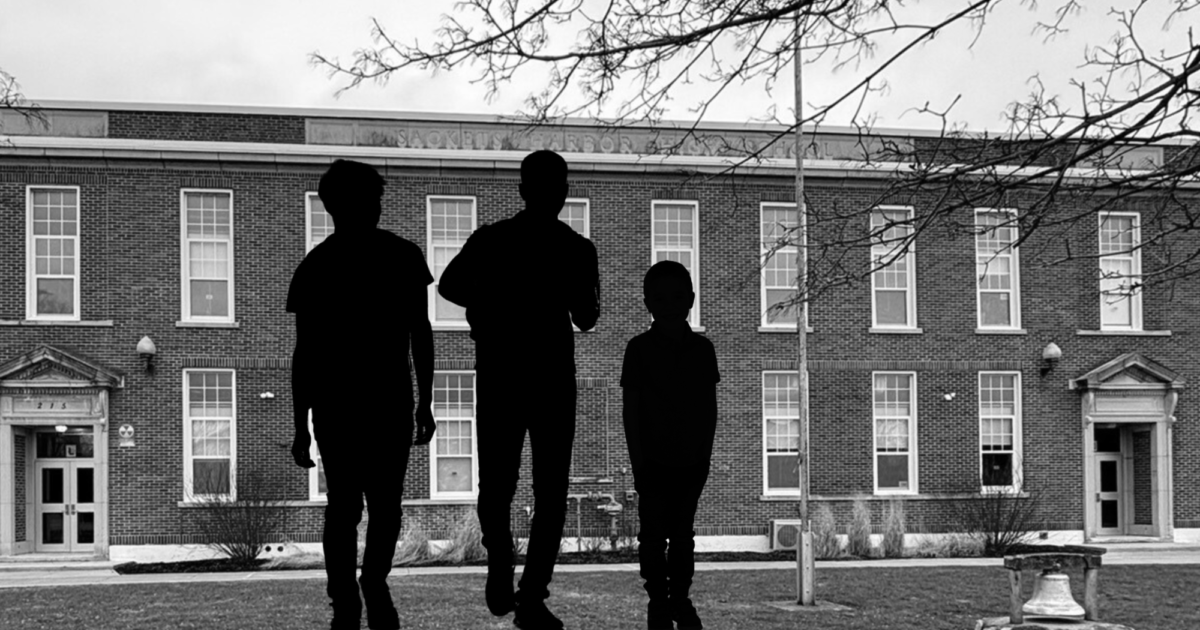
Governor would appoint two members to expanded La. Public Service Commission under proposal
By: Wesley Muller - April 9, 2025
State lawmakers will consider a proposal this spring to let the governor add two at-large members to the Louisiana Public Service Commission, meaning voters would no longer elect all members of one of the state’s most powerful political institutions.
House Bill 364, sponsored by Rep. Daryl Deshotel, R-Marksville, is a proposed constitutional amendment to allow the governor to hand select two additional members to the commission that regulates utilities in Louisiana. LPSC currently has five members, each elected from their respective multi-parish districts.
The two gubernatorial appointees would be able to serve two consecutive four-year terms. The five elected commissioners are currently limited to three consecutive six-year terms.
The five LPSC districts are larger and more populous than Louisiana’s six congressional districts, giving the commissioners significant influence on matters of everyday concern to residents, though an at-large commissioner would have far greater influence than the current five.
The commission determines how much utilities can charge their customers for their services that include electricity, water, gas and some telecommunications. A utility provider needs LPSC approval before raising rates or adding any kinds of fees to customers’ bills.
The commission oversees major investor-owned utilities such as Cleco and Entergy Louisiana, as well as smaller, member-owned power cooperatives such as DEMCO. Its regulatory umbrella covers the entire state, save for a handful of city-owned utilities and private service providers in New Orleans and other cities, which fall under the jurisdiction of local governments.
LPSC members also have oversight of intrastate oil pipelines, tow truck services and moving companies. Each commissioner is also supposed to represent constituents in their districts in any disputes they have with utility companies.
“It only takes three members to control rates over the entire state,” Deshotel said, referring to the three-vote majority needed for a measure to pass on the five-member panel. “I just think we need more representation.”
Some are skeptical of the proposal.
Commissioner Jean-Paul Coussan, a Republican and former state senator from Lafayette, said he has great respect for the legislative process and his former colleague but doesn’t think the addition of two appointed members would accomplish Deshotel’s stated intention of increasing representation.
“They wouldn’t be answerable to a constituency, so it kinda defeats the purpose of his goal,” Coussan said. “I don’t see how two appointees who only answer to the governor would accomplish that.”
Coussan said Deshotel’s proposal would drastically overhaul an institution that works with companies and residents through regulatory processes that have been relatively consistent over the years. Such changes would send a discouraging message to the major stakeholders investing in Louisiana who are familiar with and rely on the LPSC’s stable regulatory environment, he added.
Read More:
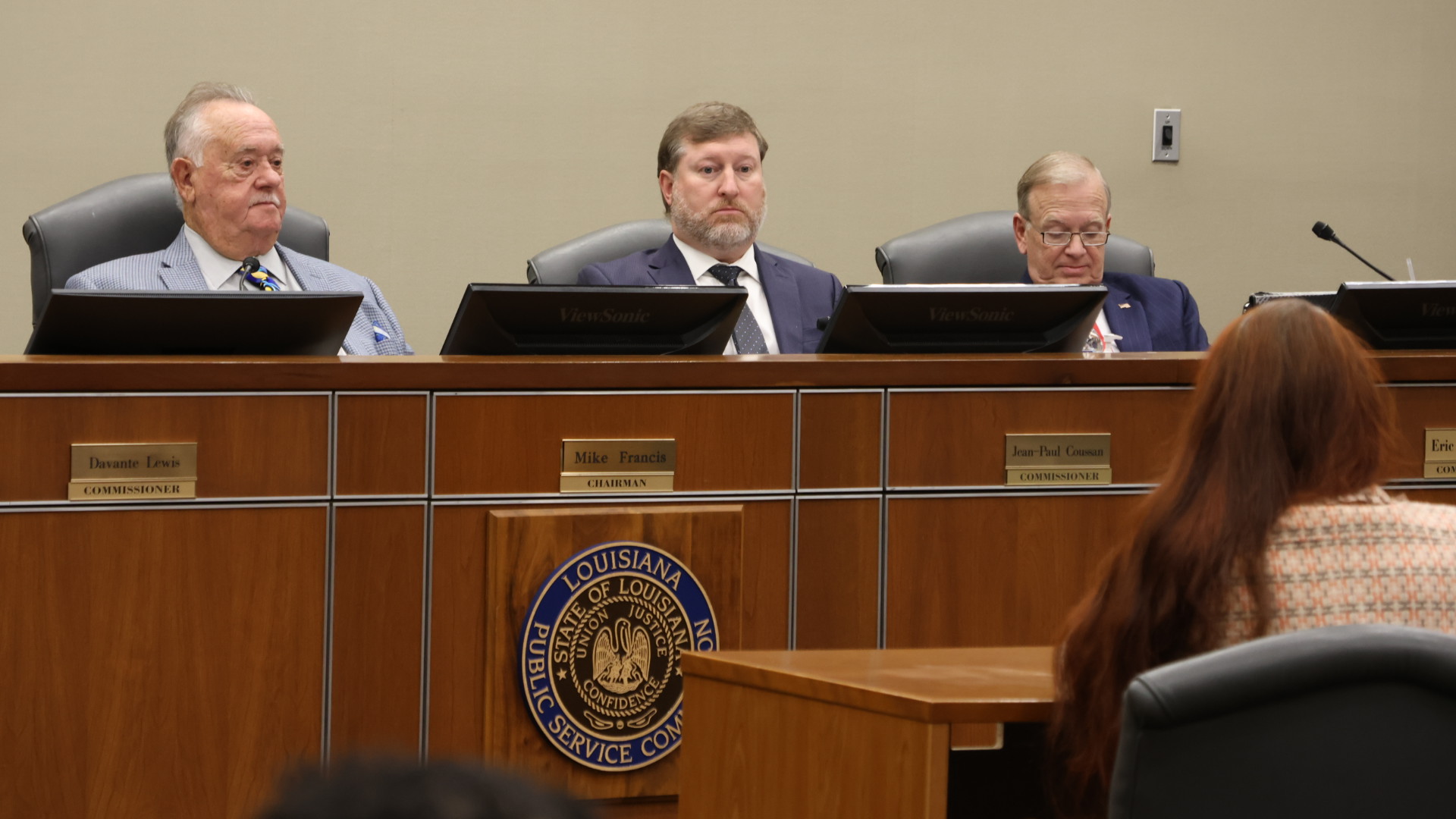
Rep. Terri Sewell Says Protests Can Get the Trump Administration to Reverse Course
The Alabama Democrat pointed to some examples of DOGE backtracking after public backlash.
April 8, 2025
Democratic Rep. Terri Sewell urged her constituents to mobilize in order to pressure the Trump administration to reverse course on some of its efforts to revise history.
The Alabama lawmaker said this approach has already gotten results, pointing to the Department of Government Efficiency removing the Montgomery Greyhound Bus Station from a list of federal historic sites it initially listed as for sale and calling it a “win” for the Democratic Party.
“When we amplify our voices, when we call out the outrageousness of the actions that are being taken, they have a tendency to reverse their orders,” Sewell said Tuesday during a telephone town hall in response to a question her staff read from a constituent about what she was doing to prevent the Trump administration from erasing Black history.
“I think we have to be vigilant about that,” Sewell said.
She pointed to a joint press conference she held with fellow Alabama Rep. Shomari Figures and House Minority Leader Hakeem Jeffries on the “outrageous” decision to include the building on the list, and said reversing the move was an example of what her party, which is out of power, can do to slow down President Donald Trump.
The Montgomery Greyhound Bus Station, now a museum dedicated to remembering the Montgomery bus boycott, was one of more than 400 federal buildings that were first listed on the General Services Administration’s website as “non-core” properties that could be closed or sold. Not long after its initial posting, the list was taken down. Now the website currently has an abbreviated list of sites “identified for accelerated disposition” that does not include the bus station.
The Trump administration has also taken aim at other historical institutions. Last month, the administration issued an executive order targeted at Smithsonian institutions that left open the question of whether exhibits would be removed from the National Museum of African American History and Culture.
“I’m mobilizing with other members of Congress and with outside organizations, and I hope with you all to have our collective voice be heard,” Sewell said. “That is unacceptable, unacceptable. To take away exhibits and from the National African American Museum, and under our watch we’re not going to stand by idly without a fight.”
In January, the Air Force scrubbed information from its training courses about the Tuskegee Airmen, the country’s first Black military pilots who served in a segregated unit during World War II, but reversed the decision after public outcry. Reinstating the information was another example Sewell pointed to of “a win” against the Trump administration.
“We know that the Tuskegee Airmen are heroes,” Sewell said. “They are patriots. They have been celebrated by the Air Force and by all the services as being the only unit that led those bombers and never lost a plane. So we pushed back, we held press conferences, we issued statements. And lots and lots of you demanded that it be returned. And so it was. That’s a win.”
At the end of her town hall, Sewell emphasized to her constituents that they play a big part in Democrats “mobilizing” efforts, and she needs them to “stay engaged and to stay involved.”
“It is no coincidence that the Trump administration has already backtracked on several of its unpopular policies, whether it was funding freeze or the selling of the Montgomery Greyhound Bus Station. Those reversals happened because the American people spoke up and made their voices heard.”
—
Torrence Banks is a NOTUS reporter and an Allbritton Journalism Institute fellow.

These States Have Investigated Miscarriages and Stillbirths as Crimes
A recent arrest in Georgia highlights the criminal suspicion that surrounds pregnancy loss in several states, experts say.
This article was first published by The Marshall Project, a nonprofit news organization covering the U.S. criminal justice system. Sign up for their newsletters, and follow them on Instagram, TikTok, Reddit and Facebook.
In late March, police in southern Georgia arrested a 24-year-old woman who had a miscarriage after a witness reported seeing her place the fetal remains in a dumpster.
The coroner in Tift County determined it was a 19-week fetus from a naturally occurring miscarriage, but some legal experts consider the arrest a bellwether for the criminal suspicion that surrounds pregnancy loss in many states in post-Roe America.
The Marshall Project previously examined how the way a person handles a pregnancy loss — and where it occurs — can mean the difference between a private medical issue and a criminal charge.
Nationally, federal data shows that about 20% of pregnancies end in a loss, but only a small number are investigated as crimes. In several states, a positive drug test after a pregnancy loss can result in criminal charges for the mother, and even prison time.
Prosecutions related to pregnancy appear to have increased since the Supreme Court decision that overturned Roe v. Wade in 2022, according to Pregnancy Justice, a nonprofit that advocates for the legal rights of pregnant people. In the first year after the Dobbs decision — from June 2022 to June 2023 — there were at least 210 pregnancy-related prosecutions, researchers for the group found.
Here are some states where miscarriages and stillbirths have been investigated by the criminal legal system in recent years:
Alabama
Alabama has a broad “chemical endangerment of a child” law allowing prosecutors to charge someone for drug use during any part of a pregnancy, whether the mother delivers a stillborn fetus or a healthy newborn.
Our 2022 investigation with AL.com found that more than 20 women had been prosecuted after a miscarriage or stillbirth in Alabama. Some of the harshest sentences resulted in cases where a fetus was stillborn and the woman went to trial.
The Pregnancy Justice report examining nationwide prosecutions related to conduct associated with pregnancy, pregnancy loss or birth in the first year after the Dobbs ruling found that nearly half of the cases came from Alabama.
Arkansas
Arkansas is among several states that still make it a crime to “conceal” a birth or stillbirth. Such laws date back to the 17th century, and were intended to shame and accuse women of crimes if they were pregnant and unmarried.
In 2015, Annie Bynum walked into a hospital with a plastic bag containing the remains of her stillborn fetus and ended up going to jail — and eventually prison. She was accused under the concealment law.
A jury originally convicted and sentenced Bynum to six years in prison. Later, an appeals court ruled that the jury shouldn’t have been allowed to hear evidence that Bynum ingested medications to induce labor before the stillbirth or had previously had abortions — because the charge was that she had concealed the pregnancy, not tried to end it. While pregnant, Bynum had planned to quietly let a friend adopt the baby, and she eventually pleaded guilty to a legal violation for the attempted adoption.
California
In 2022, the state passed a law banning investigations and prosecutions of pregnancy loss.
But prior to that law, at least two California women had already served time in jail and prison for stillbirths that prosecutors had alleged were related to drug use.
Adora Perez had served nearly four years of an 11-year sentence before a judge ruled her plea agreement — to a charge of voluntary manslaughter of a fetus — was unlawful, and overturned her conviction in 2022.
That only happened after the case of then-26-year-old Chelsea Becker garnered international outrage. Becker was charged with “murder of a human fetus” in 2019, but the case was dismissed in 2021 and led to Perez’s case getting a second look. Anger about the prosecutions of both women led to the change in state law, to avoid punishing “people who suffer the loss of their pregnancy.”
Georgia
At least one woman who had a miscarriage has been arrested under a state law that makes it a crime to conceal a dead body, punishable by up to 10 years in prison.
On March 20, police in Tifton, Georgia, issued a press release announcing that a dead fetus had been found in a dumpster at an apartment complex, after an ambulance was called for a woman who was found bleeding and unconscious. The next day, the Tifton Police Department announced it had arrested the woman who miscarried that fetus, accusing her of one count of concealing the death of another person and one count of abandonment of a dead body.
On April 4, Tift County District Attorney Patrick Warren announced that his office was dropping charges against the woman. His office determined that neither charge was applicable to her case under Georgia law, because a medical examiner determined the woman had a naturally occurring miscarriage.
Ohio
Ohio’s abuse of a corpse law allows a fairly broad interpretation, if applied to fetal remains: “No person, except as authorized by law, shall treat a human corpse in a way that would outrage reasonable community sensibilities.”
In 2023 in Warren, Ohio, Brittany Watts was arrested and charged with abuse of a corpse after experiencing a miscarriage at home in her toilet. She had been to a hospital prior to her miscarriage but left when she felt she was getting inadequate treatment, according to news reports. When she went back to the hospital after her miscarriage, a nurse called police and reported that Watts had given birth at home and did not want the baby — an assertion Watts’ lawyer denied. A grand jury declined to move forward with the criminal case in 2024.
Earlier this year, Watts filed a lawsuit in federal court alleging medical professionals conspired with a police officer to fabricate criminal charges against her.
Oklahoma
Criminal charges related to drug use while pregnant — in cases of pregnancy loss or infants born healthy — have become increasingly common in recent years in Oklahoma.
Kathryn Green gave birth to a stillborn baby in Enid, Oklahoma, in 2017. She was struggling with meth addiction at the time and scared. She cleaned her stillborn son’s body, wrapped him in a blanket and put him in a box. Police later found the remains in the trash and arrested her. Prosecutors initially charged her with second-degree murder, alleging that the stillbirth happened because of “meth toxicity.” But medical tests later showed otherwise: Green’s stillborn son had an infection that had caused his death, records show.
In 2022, Green decided to enter an Alford plea — a guilty plea in which the defendant maintains innocence. At her sentencing hearing, a judge said he wasn’t convinced that prosecutors had proven Green willfully and knowingly harmed her baby by using methamphetamine while pregnant, but he was bothered by her “lack of maternal instinct.”
South Carolina
South Carolina was the first state to prosecute a woman for a stillbirth allegedly due to drug use. In 2001, Regina McKnight was sentenced to 12 years in prison for giving birth to a stillborn baby who tested positive for cocaine. McKnight served eight years before the state Supreme Court overturned her conviction, in part because her trial lawyer didn’t present witnesses to challenge prosecutors’ claim that her drug use definitively caused the stillbirth.
The state charged at least 200 women between 2006 and 2021 with unlawful neglect of a child or homicide by child abuse for alleged perinatal drug use.
In March 2023, a college student in Orangeburg, South Carolina, named Amari Marsh went from miscarrying a fetus in her bathroom to being investigated for a homicide. She told investigators she didn’t realize she was pregnant until she went to an ER with severe pain. She left the hospital and miscarried later in a toilet at home (which medical experts say is common). Her boyfriend at the time called 911. Police became suspicious that she may have sought to end the pregnancy or not called 911 fast enough, records show. She was jailed and accused of homicide by child abuse — before the fetus was autopsied.
An autopsy showed later that the fetus died of natural causes due to an infection that Marsh was unaware of, her lawyer said. In South Carolina, police can arrest someone on a criminal complaint without approval from local prosecutors (called solicitors). After a grand jury reviewed all of the evidence in the case, the charges against Marsh were dismissed.
This story was updated on April 4 after charges against a woman in Tifton, Georgia, were dropped.
Flood risks getting worse along US coastlines, new analysis shows
Researchers predict rising seas will increase severe flood risks for about 2.5 million Americans by 2050.
Terry L. Jones/Floodlight
Apr 2, 2025
Published by Louisiana Illuminator, The Invading Sea, Mississippi Today
Flooding in coastal areas of the United States is projected to occur 10 times more often over the next 25 years, with about 2.5 million people and 1.4 million homes facing severe property damage from sea level rise, according to a new analysis released Wednesday by Climate Central.
And that’s only if countries keep their commitments to reduce greenhouse gas emissions by 2050 as outlined in the Paris Agreement — the international treaty geared toward climate mitigation and greenhouse reduction. President Donald Trump pulled the United States — the No. 2 greenhouse gas emitter after China — from the agreement days after entering office, saying it would strengthen the U.S. economy.
“The current administration is going in kind of the opposite direction of where data says we would need to go if we want to reduce risk,” said Kristina Dahl, vice president of science for Climate Central, a nonprofit group of independent scientists and climate change researchers
Climate Central has developed a Coastal Risk Finder tool for the public and policy makers to map the flooding risks for their parts of the country. It paints a dire picture for people living along coastal Florida, New York and New Jersey, where it predicts the largest number of people and homes at risk from severe flooding.
The Gulf Coast region will also see higher rates of sea level rise, the analysis found. The area’s low-lying coasts means larger land areas are at risk of flooding, but Louisiana has a less dense population.
Read More:

Utah men charged in deadly DRC coup attempt; charges detail training, recruitment in Utah
by Kyle Dunphey, Utah News Dispatch
April 10, 2025
Before their failed attempt to violently overthrow the president of the Democratic Republic of Congo, the four men now charged with conspiracy in federal court spent time training, recruiting and planning their coup attempt in Utah.
That’s according to a newly unsealed complaint, filed in Utah’s U.S. District Court over the weekend. If convicted, each man could face life in prison.
It’s the latest development in the story that broke last year after armed rebels attempted to oust DRC President Félix Tshisekedi and Deputy Prime Minister for the Economy Vital Kamerhe.
The ringleader, 41-year-old Christian Malanga, was shot and killed by DRC security forces during the attack on May 19, 2024 — his son and three associates were captured and sentenced to death by Congolese authorities. But on Tuesday, they were repatriated to the United States, and on Wednesday, the 82-page complaint against them was unsealed.
Now, Marcel Malanga, 22, Tyler Thompson, 22, Benjamin Zalman-Polun, 37, and Joseph Peter Moesser, 67, have all been charged with various counts of conspiracy.
À la suite de la grâce présidentielle accordée aux trois détenus américains ayant bénéficié de la commutation de leurs peines en servitude pénale à perpétuité, en collaboration avec @USEmbKinshasa
Marcel, Benjamin et Taylor ont été évacués aux Etats-Unis pour y purger leur peine pic.twitter.com/IE6f9aHEGE
— Tina Salama (@TinaSalama2) April 8, 2025
The failed takeover left at least six people dead, including Malanga, and 37 facing execution. For the past year it has made headlines worldwide, particularly for the Americans’ involvement and videos and images of the attack and capture that spread online.
Now back in the U.S., the four men, if convicted, could be sentenced to life in prison for conspiracy to use weapons of mass destruction, conspiracy to bomb places of government facilities, and conspiracy to kill or kidnap persons in a foreign country. They also face a possible 15-year sentence for conspiracy to provide material support and resources.
Marcel Malanga and Thompson could each face an additional 15-year sentence for taking a firearm out of the United States to engage in a felony.
Malanga, Thompson and Polun are expected to make their initial appearances at the federal courthouse in Brooklyn, New York, according to the U.S. Department of Justice, but will likely appear in Salt Lake City for further proceedings. Moesser is expected to make his initial appearance on Thursday, April 10 at the federal courthouse in Salt Lake City.
Who are the men behind the attack?
Christian Malanga was a DRC native with permanent U.S. residency who had been living in Utah since the late 1990s. He moved back to the DRC in 2006, enlisted in the military and became politically active, eventually leading the United Congolese Party, prosecutors say. He declared himself president of the “New Zaire Government in Exile” in 2017.
His son, Marcel Malanga, was born in Utah and lived in West Jordan. According to the charges, he recruited people to join the rebel army, and supplied equipment, explosives and training.
Thompson also lived in West Jordan, and according to court documents, was close with Marcel Malanga — they were high school classmates, football teammates, and worked together. FBI agents who worked the case believe he was tasked with being the drone operator.
Polun had lived all over the world, according to the complaint, including Virginia, Nicaragua, England, Belgium, Republic of Georgia, Senegal and Eswatini. He took multiple trips to Utah between 2023 and 2024, and prosecutors say he was in Utah working construction with Marcel Malanga in winter 2024. Polun is described in the complaint as Christian Malanga’s chief of staff, and if the coup was successful, would “work in finance” under the new administration.
And Moesser lived in West Valley City. His role, “among other things, was to design, manufacture, and provide assembly instructions for destructive devices. He also intended to provide sniper support during the attack,” according to the charges.
New details on training and recruiting efforts in Utah
The unsealed complaint shines a new light on how the four men trained, bought equipment and recruited people in the Salt Lake City area during the months leading up to the coup attempt.
According to the complaint, Marcel Malanga and Thompson were offering potential recruits $50,000 to “go to Africa to ‘invade’ someone’s home and to join their military expedition,” according to court documents. One of the recruiting meetings took place between Polun, Marcel Malanga and an unnamed individual at a restaurant in West Jordan.
Marcel Malanga at one point described the coup as an attempt to “go take out some terrorists,” comparing it to “Call of Duty stuff,” court documents read. He told another person it would be like “secret service work” for his father.
GET THE MORNING HEADLINES.SUBSCRIBE
Marcel Malanga and Thompson bought and stockpiled drones to be used in the coup, at least one of which was later outfitted with a flame thrower in West Valley City. They also discussed equipping drones with pipe bombs at Moesser’s home, while Marcel Malanga bought drone equipment and had it shipped to an address in Draper, prosecutors say.
Images included in the complaint show Moesser, sitting in his home in Utah, discussing an explosive device that could be dropped from a drone. And according to the complaint, Thompson practiced flying drones in Utah.
Some of the firearms used in the attack were purchased in Salt Lake City, and the complaint includes two pictures of U.S. Customs and Border Protection forms signed by Marcel Malanga and Thompson, which were used to register and take firearms abroad. The forms were signed on April 9, 2024, in Salt Lake City.
The men also practiced shooting firearms at a number of gun ranges in the Salt Lake City area, documenting it on their social media channels. Surveillance footage shows Marcel Malanga and Thompson training with handguns and rifles at a Utah shooting range.
Marcel Malanga would eventually order 25 patches with the flag of the former Republic of Zaire from a Utah-based company — he was later caught on video during the attack with a similar patch on his arm.
Both Marcel Malanga and Thompson departed on April 10, 2024, from the Salt Lake City International Airport, according to the charges, arriving in Johannesburg, South Africa, two days later, where they continued training. By the end of April 2024 they were in the DRC, scouting for the coup.
Failed coup leaves at least six people dead
The attempted coup began in the early morning hours of May 19, 2024, when an unknown number of armed men met Christian Malanga in a hotel in Kinshasa, the capital of the DRC. Between 2 a.m. and 3 a.m., court documents say Christian Malanga and the men attacked a police station, where they stole more weapons.
Then at 3:30 a.m., Christian Malanga carjacked a Range Rover belonging to someone identified as “victim #1,” whom Malanga shot and killed, according to the charges. At about 4:30 a.m., the rebel force arrived at the home of Kamerhe, the deputy prime minister, where one of the rebels and two guards were killed.
By 5 a.m., the rebels traveled to the Palais de la Nation, the DRC president’s official residence and workplace — up to this point, Marcel Malanga, Thompson, and Polun’s involvement in the fighting is unclear in the complaint. But according to social media footage, the three men accompanied the rebel forces to the president’s home.
After being confronted by DRC security forces, Christian Malanga was shot and killed, and Marcel Malanga, Thompson and Polun fled. By 10 a.m., the men were captured. At least six people were killed.
Moesser’s involvement that morning is unclear, and he is not mentioned in the complaint’s summary of the attack. He “also stated that he had every intent on joining” the rebel army “in Africa to participate in the attack. He stated that he was going to be a sniper,” the complaint reads.
YOU MAKE OUR WORK POSSIBLE.SUPPORT
Utah News Dispatch is part of States Newsroom, a nonprofit news network supported by grants and a coalition of donors as a 501c(3) public charity. Utah News Dispatch maintains editorial independence. Contact Editor McKenzie Romero for questions: info@utahnewsdispatch.com.
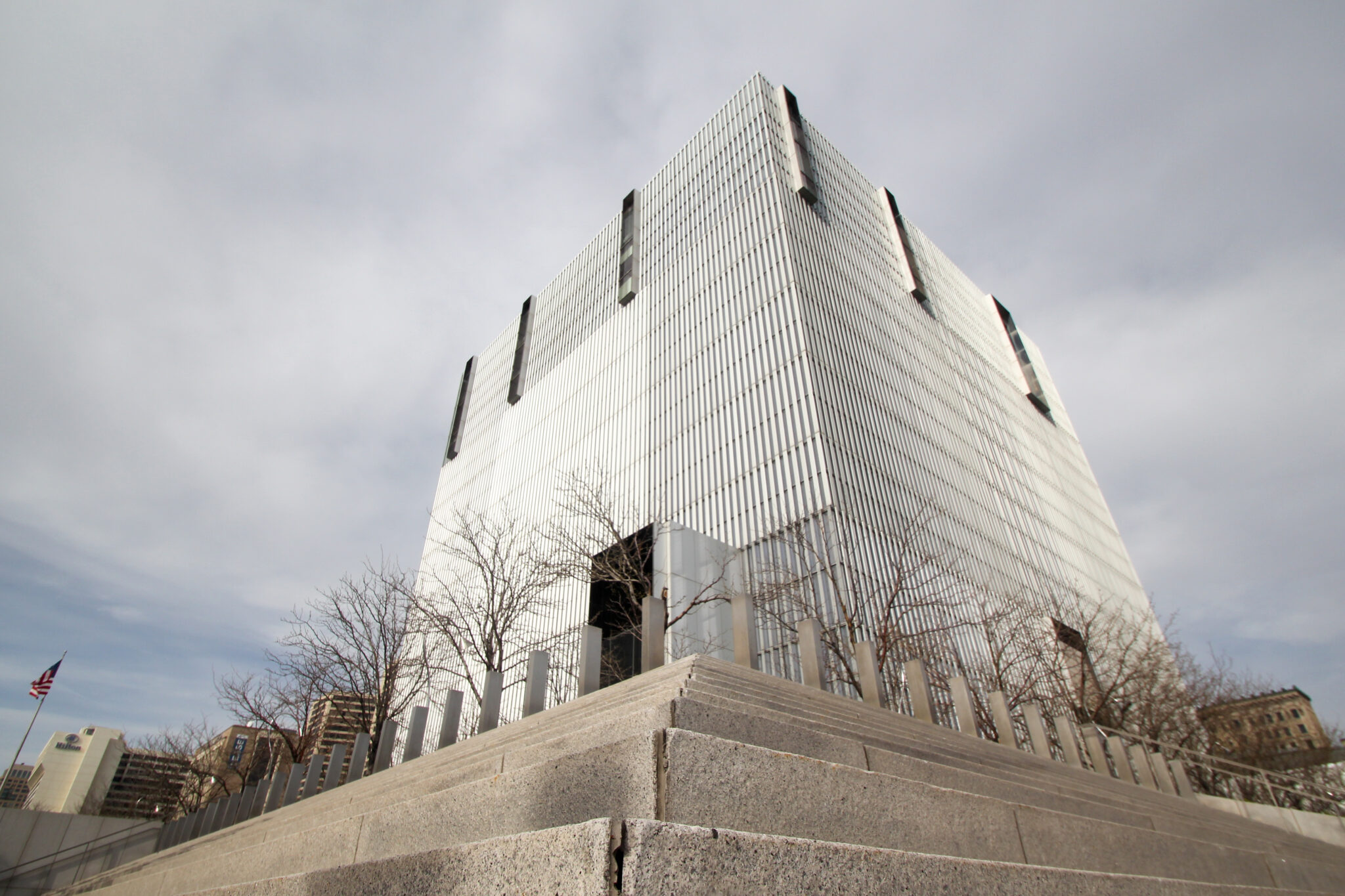
‘A despicable company’: Vermonters protest proposed Amazon facility in Essex
More than two dozen residents rallied outside the Essex Town Hall on Thursday, and later spoke at the town’s Development Review Board meeting.
April 4, 2025
This story was updated on April 5.
Katie DeSanto, the general manager of Phoenix Books, first heard of the plans through a customer: a proposal to build a 107,000 square-foot Amazon distribution facility in Essex.
Soon after, she posted on the company’s social media page where she raised concerns about the company’s business practices and their employees’ working conditions.
The post drew some attention, and since then, dozens of Vermont residents have decried Amazon’s plans for a proposed distribution facility in Vermont. On Thursday, more than two dozen people rallied against the proposal outside the Essex Town Hall — the first of what protesters say will be many.
The plant could be in Phoenix Books’ backyard — the locally-owned shop has locations in Essex and Burlington — but DeSanto said that isn’t her only concern.
“This isn’t only about its devaluing of books, although that’s where our obvious interest lies,” DeSanto wrote. “It’s also about the business practices. It’s about their human labor practices. It’s about not paying taxes.”
Amazon, the online retail behemoth, first submitted site plan applications to the town in March. Titled “Project Moose,” the proposal, if approved, would build a distribution facility on 22.94 acres of land in Essex’s Saxon Hill Industrial Park off of Thompson Drive, according to Essex Development Review Board documents.
The town’s Conservation and Trails Committee first heard the proposal, and the town’s Development Review Board reviewed it on March 20.
If approved, it would be the first Amazon facility in Vermont. Amazon has a growing presence in New England, with the company’s largest facility in the region opening in 2023 in Windsor, Connecticut.
Dozens of speakers spoke out against the project when the DRB first reviewed the proposal. The vast majority of speakers expressed concerns about what the facility would do to local traffic and the environment, and highlighted the company’s record of hazardous and low-paying working conditions.
Those protests have since continued, and on Thursday evening, DeSanto and more than two dozen other Vermont residents protested outside of Essex’s Town Hall to rally against Amazon’s proposed facility.
She and others at the rally said they were concerned the project would affect residents who live in the area, and would negatively affect small businesses in the state.
Read More:
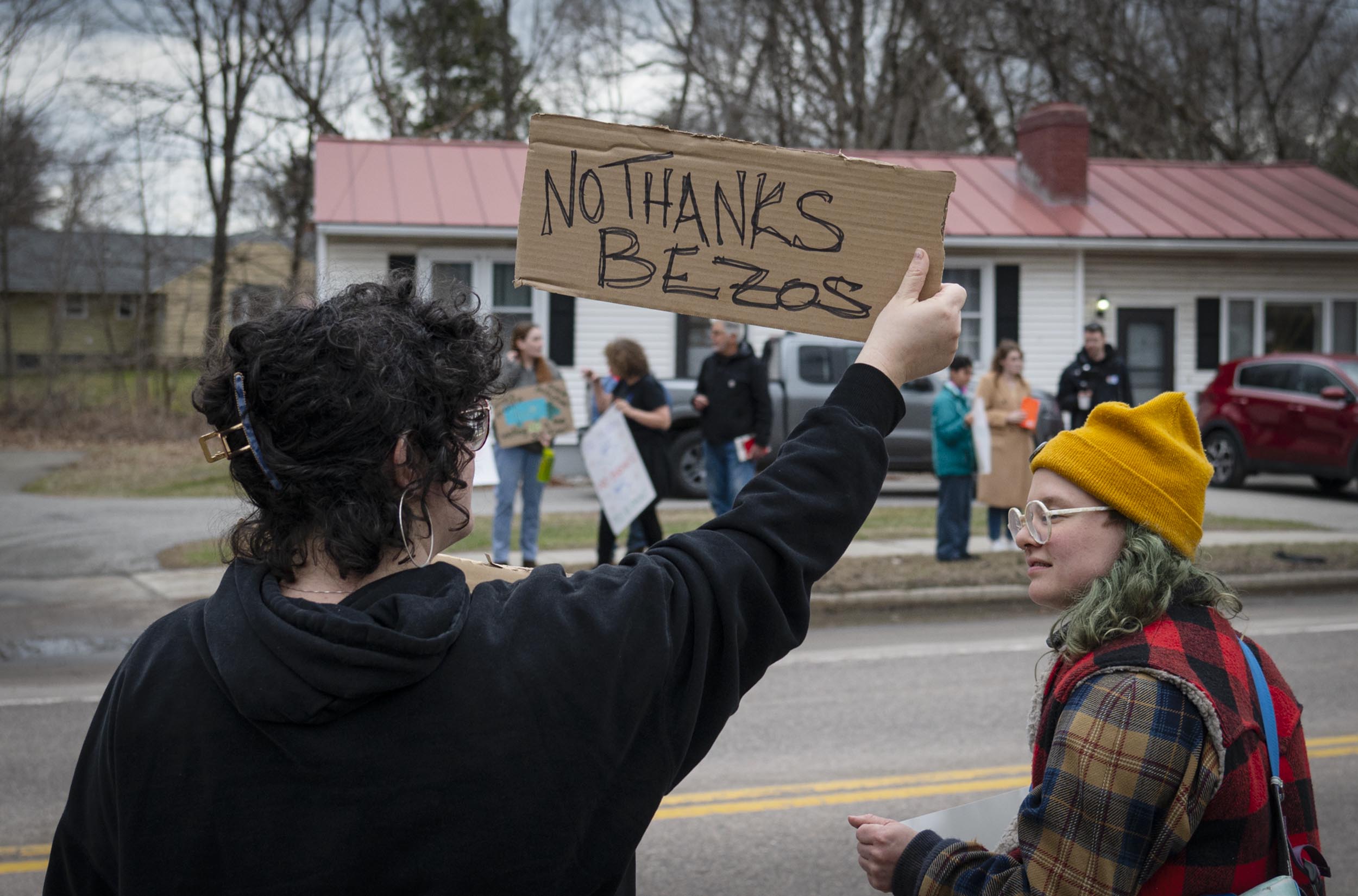
Adams Administration Inks Executive Order Allowing ICE Back on Rikers Island
After the Trump administration demanded the mayor’s cooperation on immigration enforcement, a deputy authorizes federal officials to resume operations at the city’s jail complex.
by Gwynne Hogan and Reuven Blau
April 9, 2025
New York City First Deputy Mayor Randy Mastro signed an executive order Tuesday allowing Immigration and Customs Enforcement to reestablish an office on Rikers Island, rolling back a provision of the city’s sanctuary protections that had been on the books for more than a decade.
Mastro’s order cited “transnational gangs such as MS-13 and Tren de Aragua,” which have recently been designated terrorist organizations by the Trump administration and named in deportation actions. “It is critical that federal law enforcement agencies are able to share intelligence with the DOC and NYPD in real-time about criminal gang activity among individuals both inside and outside of DOC custody,” Mastro wrote as a justification to allow federal immigration authorities back onto the island jail complex.
The move was swiftly slammed by criminal justice and immigration rights advocates, who contend it will reopen a pipeline from city jails to deportation proceedings that had previously ensnared around 3,500 people a year before a 2014 law barred ICE from operating on Rikers Island.
“Exactly ten years ago today, on Valentine’s Day, ICE’s trailer on Rikers Island was shut down,” the Bronx Defenders, a public defense organization, said in a statement. “Yet rather than celebrate this historic milestone, the Mayor is rolling back the clock as he attempts to reopen the door to deportation in New York City jails.”
The executive order came more than a month after Mayor Eric Adams had promised he would draft such an order, following a meeting with President Donald Trump’s “border czar” Tom Homan and a demand by the U.S. Department of Justice to dismiss corruption charges against Adams in order, it said, to ensure his cooperation on immigration enforcement.
Read More:
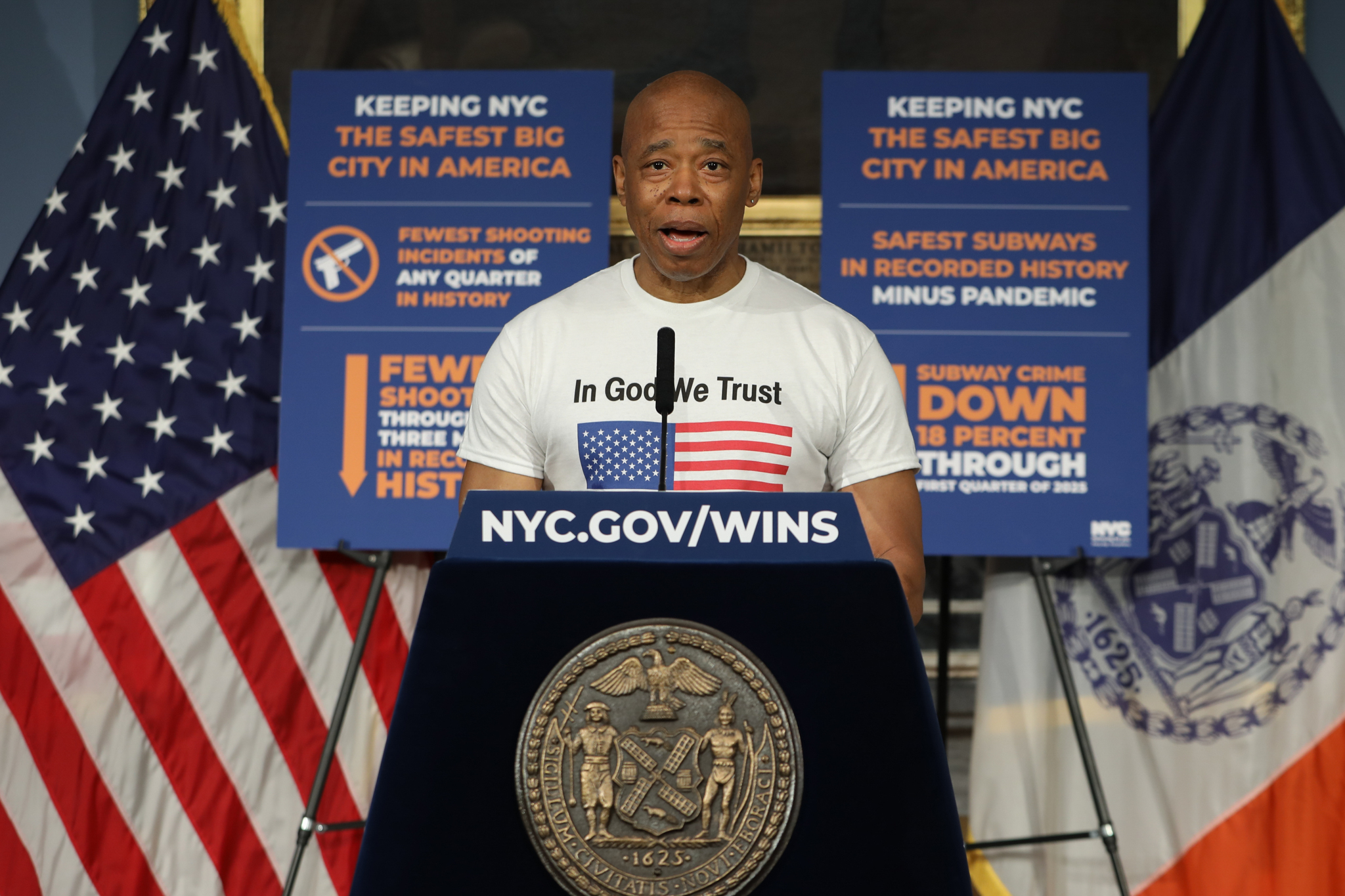
-30-













